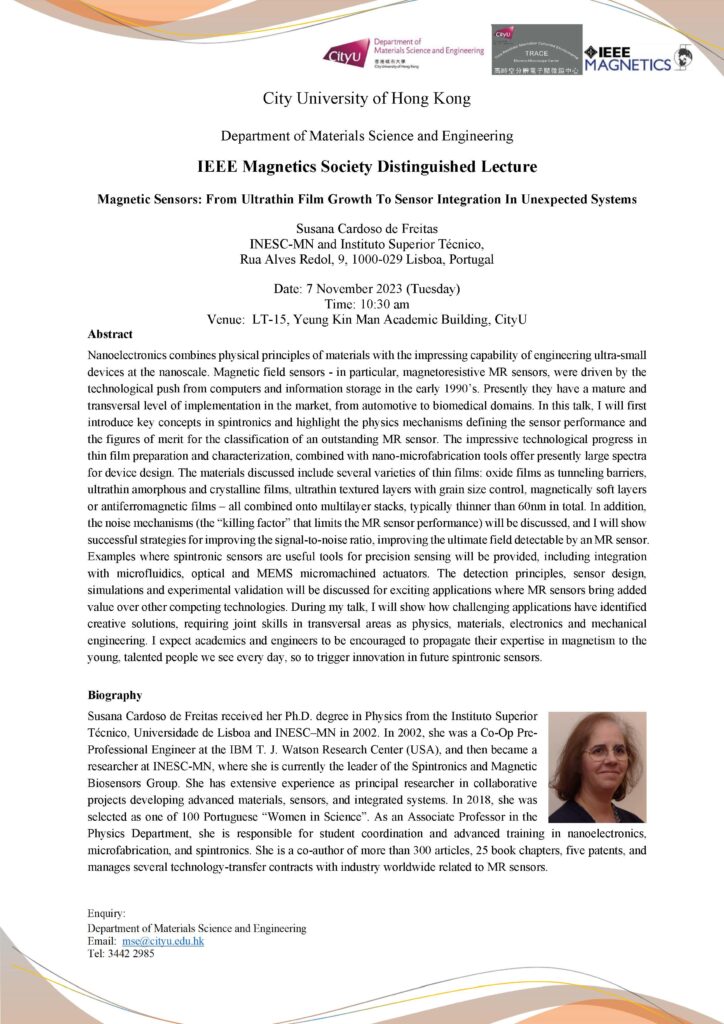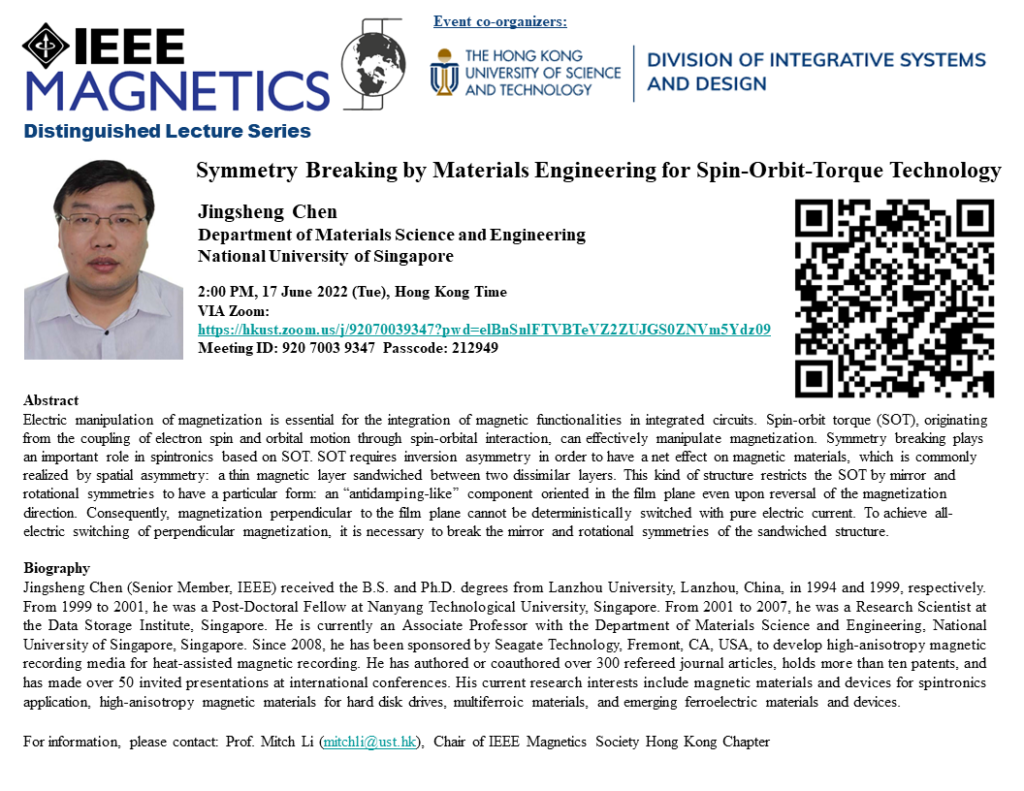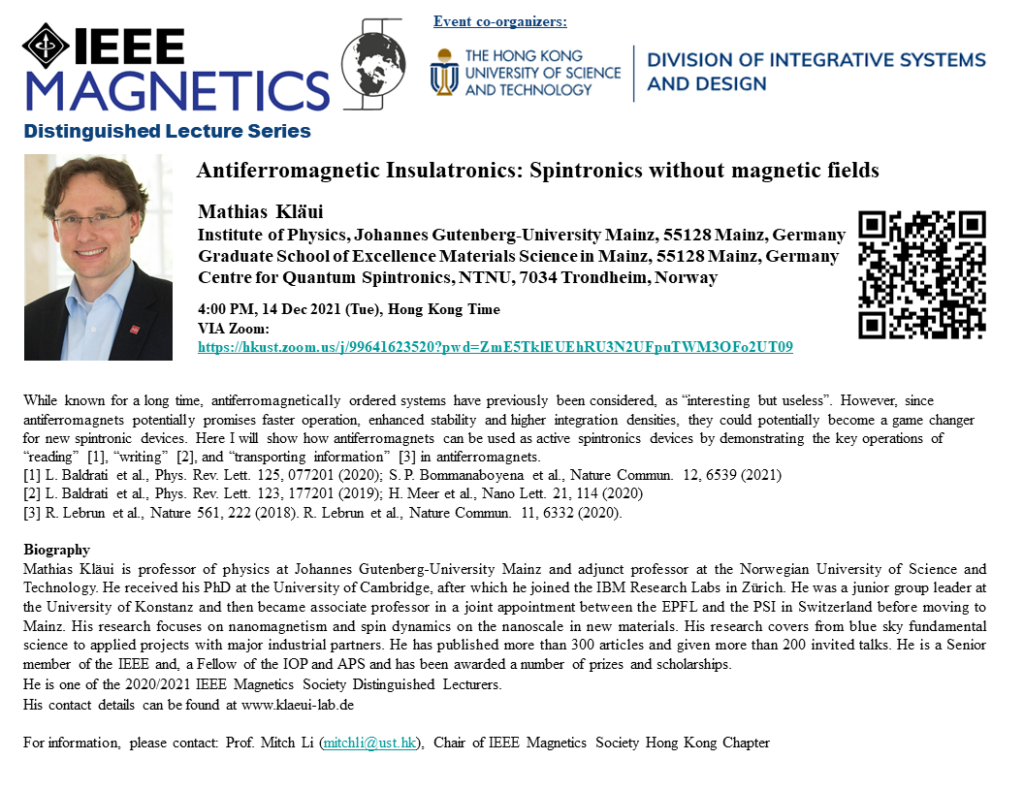Distinguished Lecture – Magnetic Sensors: From Ultrathin Film Growth to Sensor Integration In Unexpected Systems


Jingsheng Chen
National University of Singapore
Electric manipulation of magnetization is essential for the integration of magnetic functionalities in integrated circuits. Spin-orbit torque (SOT), originating from the coupling of electron spin and orbital motion through spin-orbital interaction, can effectively manipulate magnetization. Symmetry breaking plays an important role in spintronics based on SOT. SOT requires inversion asymmetry in order to have a net effect on magnetic materials, which is commonly realized by spatial asymmetry: a thin magnetic layer sandwiched between two dissimilar layers. This kind of structure restricts the SOT by mirror and rotational symmetries to have a particular form: an “antidamping-like” component oriented in the film plane even upon reversal of the magnetization direction. Consequently, magnetization perpendicular to the film plane cannot be deterministically switched with pure electric current. To achieve all-electric switching of perpendicular magnetization, it is necessary to break the mirror and rotational symmetries of the sandwiched structure.
In this lecture, I will begin with a basic introduction of the physical origin of SOT, followed by the related symmetry analysis of a magnetic thin film in a sandwiched structure for the generation of a net SOT effect. Then, I will introduce a new method—a composition gradient along the thin-film normal for breaking the inversion symmetry—to generate bulk-like SOT [1], which enables a thicker magnetic layer with high magnetic anisotropy. An overview of the methods commonly used to break mirror and rotational symmetries to realize all-electric switching of perpendicular magnetization will follow. I will give a detailed discussion on our methods for the realization of all-electric switching of perpendicular magnetization: the use of a spin source layer with low magnetic symmetry and low crystal symmetry, which generates an out-of-plane SOT [2]–[4]; interfacial 3m1 symmetry, which induces a new “3m” spin torque [5]; precise control of the tilting of magnetocrystalline anisotropy easy axis [6]; and a spin-current gradient along the current direction [7].
[1] L. Liu et al., “Electrical switching of perpendicular magnetization in a single ferromagnetic layer,” Phys. Rev. B, vol. 101, 220402, June 2020.
[2] J. Zhou et al., “Magnetic asymmetry induced anomalous spin-orbit torque in IrMn,” Phys. Rev. B, vol. 101, 184403, May 2020.
[3] J. Zhou et al., “Large spin-orbit torque efficiency enhanced by magnetic structure of collinear antiferromagnet IrMn,” Sci. Adv., vol. 5, eaau6696, May 2019.
[4] Q. Xie et al., “Field-free magnetization switching induced by the unconventional spin–orbit torque from WTe2,” APL Mater., vol. 9, 051114, May 2021.
[5] L. Liu et al., “Symmetry-dependent field-free switching of perpendicular magnetization,” Nat. Nanotech., vol. 16, pp. 277-282, January 2021.
[6] L. Liu et al., “Current-induced magnetization switching in all-oxide heterostructures,” Nat. Nanotech., vol. 14, 939-944, September 2019.
[7] S. Chen et al., “Free field electric switching of perpendicularly magnetized thin film by spin current gradient,” ACS Appl. Mater. Interfaces, vol. 11, pp. 30446-30452, July 2019.
Biography
Jingsheng Chen (Senior Member, IEEE) received the B.S. and Ph.D. degrees from Lanzhou University, Lanzhou, China, in 1994 and 1999, respectively. From 1999 to 2001, he was a Post-Doctoral Fellow at Nanyang Technological University, Singapore. From 2001 to 2007, he was a Research Scientist at the Data Storage Institute, Singapore. He is currently an Associate Professor with the Department of Materials Science and Engineering, National University of Singapore, Singapore. Since 2008, he has been sponsored by Seagate Technology, Fremont, CA, USA, to develop high-anisotropy magnetic recording media for heat-assisted magnetic recording. He has authored or coauthored over 300 refereed journal articles, holds more than ten patents, and has made over 50 invited presentations at international conferences. His current research interests include magnetic materials and devices for spintronics application, high-anisotropy magnetic materials for hard disk drives, multiferroic materials, and emerging ferroelectric materials and devices.
Dr. Chen has served as the Program Chair for the 2018 International Magnetics Conference.
Contact: Jingsheng Chen, Department of Materials Science and Engineering, National University of Singapore, Singapore; e-mail: [email protected].
4:00 PM, 14 Dec 2021 (Tue), Hong Kong Time
VIA Zoom:
https://hkust.zoom.us/j/99641623520?pwd=ZmE5TklEUEhRU3N2UFpuTWM3OFo2UT09

While known for a long time, antiferromagnetically ordered systems have previously been considered, as “interesting but useless”. However, since antiferromagnets potentially promises faster operation, enhanced stability and higher integration densities, they could potentially become a game changer for new spintronic devices. Here I will show how antiferromagnets can be used as active spintronics devices by demonstrating the key operations of “reading” [1], “writing” [2], and “transporting information” [3] in antiferromagnets.
[1] L. Baldrati et al., Phys. Rev. Lett. 125, 077201 (2020); S. P. Bommanaboyena et al., Nature Commun. 12, 6539 (2021)
[2] L. Baldrati et al., Phys. Rev. Lett. 123, 177201 (2019); H. Meer et al., Nano Lett. 21, 114 (2020)
[3] R. Lebrun et al., Nature 561, 222 (2018). R. Lebrun et al., Nature Commun. 11, 6332 (2020).
Biography
Mathias Kläui is professor of physics at Johannes Gutenberg-University Mainz and adjunct professor at the Norwegian University of Science and Technology. He received his PhD at the University of Cambridge, after which he joined the IBM Research Labs in Zürich. He was a junior group leader at the University of Konstanz and then became associate professor in a joint appointment between the EPFL and the PSI in Switzerland before moving to Mainz. His research focuses on nanomagnetism and spin dynamics on the nanoscale in new materials. His research covers from blue sky fundamental science to applied projects with major industrial partners. He has published more than 300 articles and given more than 200 invited talks. He is a Senior member of the IEEE and, a Fellow of the IOP and APS and has been awarded a number of prizes and scholarships.
He is one of the 2020/2021 IEEE Magnetics Society Distinguished Lecturers.
His contact details can be found at www.klaeui-lab.de
For information, please contact: Prof. Mitch Li ([email protected]), Chair of IEEE Magnetics Society Hong Kong Chapter